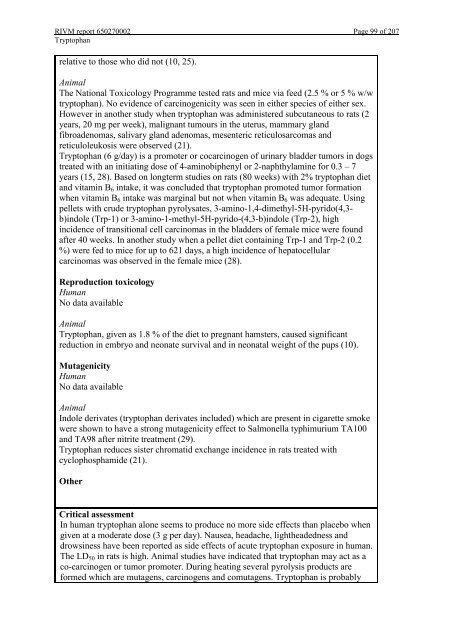The Contribution of cocoa additive to cigarette smoking addiction
The Contribution of cocoa additive to cigarette smoking addiction
The Contribution of cocoa additive to cigarette smoking addiction
You also want an ePaper? Increase the reach of your titles
YUMPU automatically turns print PDFs into web optimized ePapers that Google loves.
RIVM report 650270002 Page 99 <strong>of</strong> 207<br />
Tryp<strong>to</strong>phan<br />
relative <strong>to</strong> those who did not (10, 25).<br />
Animal<br />
<strong>The</strong> National Toxicology Programme tested rats and mice via feed (2.5 % or 5 % w/w<br />
tryp<strong>to</strong>phan). No evidence <strong>of</strong> carcinogenicity was seen in either species <strong>of</strong> either sex.<br />
However in another study when tryp<strong>to</strong>phan was administered subcutaneous <strong>to</strong> rats (2<br />
years, 20 mg per week), malignant tumours in the uterus, mammary gland<br />
fibroadenomas, salivary gland adenomas, mesenteric reticulosarcomas and<br />
reticuloleukosis were observed (21).<br />
Tryp<strong>to</strong>phan (6 g/day) is a promoter or cocarcinogen <strong>of</strong> urinary bladder tumors in dogs<br />
treated with an initiating dose <strong>of</strong> 4-aminobiphenyl or 2-naphthylamine for 0.3 – 7<br />
years (15, 28). Based on longterm studies on rats (80 weeks) with 2% tryp<strong>to</strong>phan diet<br />
and vitamin B6 intake, it was concluded that tryp<strong>to</strong>phan promoted tumor formation<br />
when vitamin B6 intake was marginal but not when vitamin B6 was adequate. Using<br />
pellets with crude tryp<strong>to</strong>phan pyrolysates, 3-amino-1,4-dimethyl-5H-pyrido(4,3b)indole<br />
(Trp-1) or 3-amino-1-methyl-5H-pyrido-(4,3-b)indole (Trp-2), high<br />
incidence <strong>of</strong> transitional cell carcinomas in the bladders <strong>of</strong> female mice were found<br />
after 40 weeks. In another study when a pellet diet containing Trp-1 and Trp-2 (0.2<br />
%) were fed <strong>to</strong> mice for up <strong>to</strong> 621 days, a high incidence <strong>of</strong> hepa<strong>to</strong>cellular<br />
carcinomas was observed in the female mice (28).<br />
Reproduction <strong>to</strong>xicology<br />
Human<br />
No data available<br />
Animal<br />
Tryp<strong>to</strong>phan, given as 1.8 % <strong>of</strong> the diet <strong>to</strong> pregnant hamsters, caused significant<br />
reduction in embryo and neonate survival and in neonatal weight <strong>of</strong> the pups (10).<br />
Mutagenicity<br />
Human<br />
No data available<br />
Animal<br />
Indole derivates (tryp<strong>to</strong>phan derivates included) which are present in <strong>cigarette</strong> smoke<br />
were shown <strong>to</strong> have a strong mutagenicity effect <strong>to</strong> Salmonella typhimurium TA100<br />
and TA98 after nitrite treatment (29).<br />
Tryp<strong>to</strong>phan reduces sister chromatid exchange incidence in rats treated with<br />
cyclophosphamide (21).<br />
Other<br />
Critical assessment<br />
In human tryp<strong>to</strong>phan alone seems <strong>to</strong> produce no more side effects than placebo when<br />
given at a moderate dose (3 g per day). Nausea, headache, lightheadedness and<br />
drowsiness have been reported as side effects <strong>of</strong> acute tryp<strong>to</strong>phan exposure in human.<br />
<strong>The</strong> LD50 in rats is high. Animal studies have indicated that tryp<strong>to</strong>phan may act as a<br />
co-carcinogen or tumor promoter. During heating several pyrolysis products are<br />
formed which are mutagens, carcinogens and comutagens. Tryp<strong>to</strong>phan is probably
















